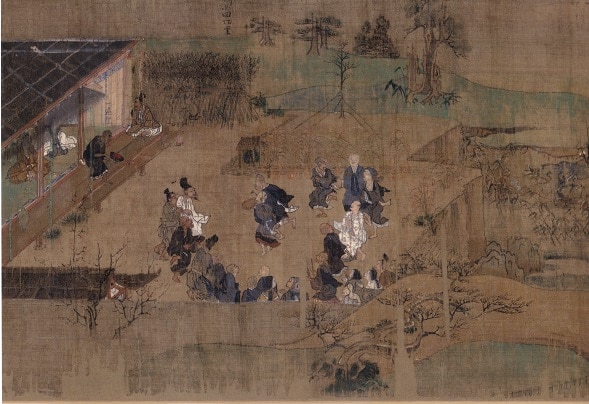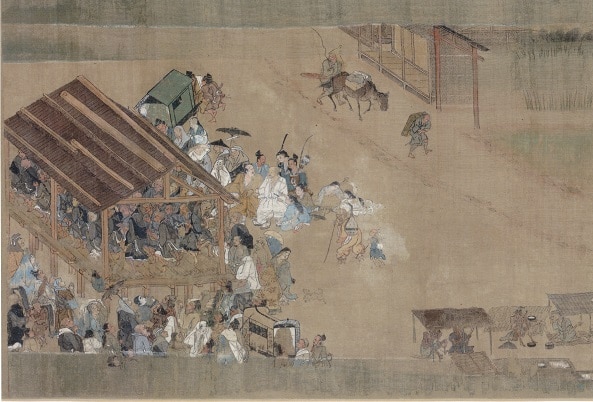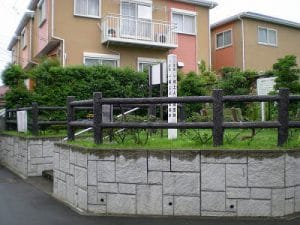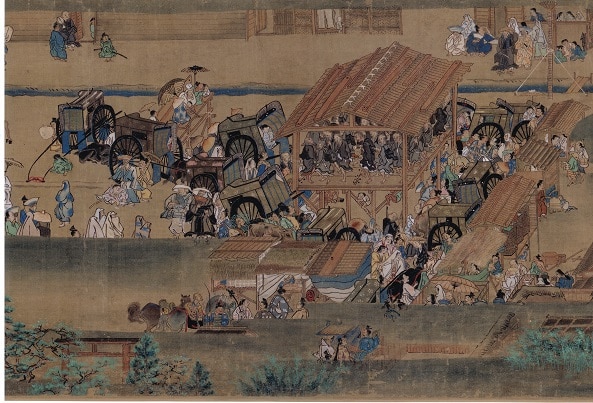Overview
In the late Kamakura period, among the New Buddhims, Ippen Shonin’s Odori Nembutu (which is thought to be one of the roots of Bon Dancing) arose. Ippen Shonin‘s dancing Buddhist chanting.
This period
Circa 1185 – 1333
1185: Establishment of the Kamakura regime
1225: Stewardship of the government
1239 – 1289: Ippen, the first Buddhist recitation of the Odori Nembutsu
1274 and 1281: The Genko Invasion
1285: Tokusou’s tyrannical rule
1333: Fall of the Kamakura Shogunate
The power of the samurai expanded and the “Kamakura Shogunate” was established. The “feudal era” began, in which the samurai took over power from the aristocrats who had monopolized politics, economics, and culture. It was during this period that the common people began to rise to power.
Basic Information
Population: Stagnant at 6 million, with many scattered villages besides the cities
Attribute types: nobles, monks, warriors, peasants, and unrelated persons Peasants are over 80% of the population
Longevity: about 30 years old
Famine and disaster conditions: Famine, plague, or disaster every 3-5 years
Media of transmission: Only aristocrats, warriors, and village rulers used letters, so it was mainly oral tradition
Territorial system, taxation: Dual control of manor management and landownership, tax payment by goods
Common people’s clothing: Simple clothing made of hemp
Common people’s food: Millet, foxtail millet, and vegetables
Dwelling of the common people: Hottate-style dwellings without a floor plan
Entertainment opportunities for the common people: limited
Religion
Religion in this period showed great movement centered on Buddhism, especially “Nenbutsu (Buddhist prayer) beliefs”. In recent years, it has become a common theory that the central force in the Buddhist world during the Kamakura period was the old Buddhism of Nara and Kyoto. However, it was also during this period that a religion for the common people (“Kamakura Buddhism”), though a minority and heretical, appeared and began to spread steadily. And the representative of the Buddhism for the common people is the “Nembutsu faith”.
Bon Odori: Events of this period
This period can be called “a turning point” in the history of Japanese performing arts. Important movements leading to later Bon dances were seen.
Odori Nembutsu: A Religion that dances (Late Kamakura Period)
Odori Nenbutsu (Dancing Nembutsu) was the origin of Bon Dancing and the origin of many later folk performing arts.
Odori Nenbutsu combines the religious aspect of “Nenbutsu faith” with the performing and entertainment aspect of “group dancing,” and was performed by a religious figure of the Kamakura period, Ippen Shonin is widely known to have popularized it.
Notable in terms of “dance.
It is also believed that Ippen adopted the Nembutsu Dancing of the Kuya lineage.
It is possible that it already existed to some extent throughout the country, such as in Kyoto Hoshina and Zenkoji Temple in Shinshu.
Nembutsu was an early form of requiem ritual and incantation (Kuya).
The Nembutsu was a requiem ritual and a spell (Kuya) from early times.
Ippen dancers danced while chanting “Namuami dabutsu,” a six-character name with verses added to the recitation of the nembutsu.
Ippen’s Dancing Nembutsu
The famous scenes depicted in the National Treasure “Ippen Hijirie” include the scene at Odagiri no Sato (present-day Odagiri, Saku City, Nagano Prefecture) in Shinshu (the birth of Odori Nembutsu), the scene of Odori Nembutsu at Katase no Hama (present-day Katase, Fujisawa City, Kanagawa Prefecture) (the first performance of Odori Nembutsu), and Odori Nembutsu at Ichiya (present-day Shimogyo Ward, Kyoto) (held at the site of the remains in memory of Kuya). The Odori Nembutsu started out as a spontaneous dance, and the entertainment and proselytizing elements were added to it, as can be clearly seen in the picture. It is said that this Odori Nembutsu eventually became one of the roots of Bon Odori, combined with Urabon events, customs, and the beliefs of the common people.
Odagiri no Sato (now Saku City, Nagano Prefecture): The scene of the birth of Odori Nembutsu

“Ippen Hijirie,” Seijohko-ji (Yugyo-ji) Collection (Permission granted, unauthorized reproduction prohibited)
| Literary name | author | remarks | Deadline | AD | Content |
|---|---|---|---|---|---|
| Ippen Holy Picture | shokai | Volume 4th Dan | Hiroyasu 2nd year | 1279 | Become a city in Banno in Saku -gun, Shinano Country, and at the end of the year, Shiun is the first time to samurai. Holding down (in the first place), Nenbutsu is paid for Soraya Kamito, Ichiya, or Shijo Tsuji. ... but more than that, even if it is a manabu, it is not a profit. It's time to be and mature now. In the country of Kotagiri no Sato, a samurai's house, the sacred and other paid, and if you are afraid, you will gradually be inherited and become a first -time manner. ~ Omitted ~ If you say, "I can't help but speak to Nenbutsu," Sacred, "Which of the Hanekoma Yo -doraba will be blurred. |
| Ippen Holy Picture | shokai | Volume 5 | Hiroyasu 2nd year | 1279 | Koyasu 2nd year, Taro Oi of Winter Shinshu Saku -gun. Samurai This is a saint of this holy ... I can do it as a Fumio Itshiki ... |
| Ippen Holy Picture | shokai | Volume 6th | Koyasu 5 years | 1282 | On March 2nd, Koyasu 5th, at the Mido and Ichinomido at Katase -no -kan, we fasted ... During the seven days, we will go to Jizo -do in Katasehama to pay for a few days. , Visit like Kazushi Aime, and crowd like Daikun. In the same way, purple clouds in March for the first time ... |
Katase-no-hama (present-day Katase, Fujisawa City, Kanagawa Prefecture)
The prosperity of Odori Nembutsu (dancing Buddhist chanting)
Ippen Shonin and his followers, who had been rejected by the Shogunate when they tried to enter Kamakura, performed dancing Nembutsu at the Jizo Hall (stage) in Katase. The festival was so popular that for several months from March to July, the holy picture vividly depicts the expressions of the people who were enthusiastic about the Nembutsu Dancing . The site of Katase Jizo Hall still remains quietly in Katase, Fujisawa City (near Shonan Kaigan Koen Station on the Enoshima Electric Railway).

“Ippen Shoe,” Seiko-ji (Yugyo-ji) Collection (Permission granted, unauthorized reproduction prohibited)
| Literary name | author | Vol | era name | AD | Content |
|---|---|---|---|---|---|
| Ippen hijirie | Shokai | Vol. 7, No. 3. | Koan 7 | 1284 | After that, he made a series of pilgrimages to Unyoji Temple, Rokuharamitsuji Temple, and other temples, and spent several days at the ruins of Kuya Shonin at Ichiya (now Kawaramachi Nishiiru Hon Shiogama-cho, Rokujo-dori, Shimogyo-ku, Kyoto) as his Buddhist center. |

The ruins of Jizo Hall in Katase, Fujisawa
Dancing Nembutsu at Ichiya (now Shimogyo Ward, Kyoto City) Dancing Nembutsu at the site of Kuya

Ippen Shoe,” Seijohko-ji Temple (Yugyo-ji Temple) (Permission granted, reproduction without permission prohibited)
| Literary name | author | Vol | era name | AD | Content |
|---|---|---|---|---|---|
| Ippen hijirie | Shokai | The first paragraph of the sixth volume | Koan 5 | 1282 | On March 2, Kouan 5, he fasted at a place called Kate-no-Midou in Katase (now Katase, Fujisawa City) and moved to Jizo-do on Katase Beach (now Katase Kaigan) during the daytime of EEEE7 and spent several days there, attracting many people regardless of their status. At that place, at the end of March, purple clouds formed and flowers began to fall. |
About Saint Ippen
In his thirties, he renounced the love of his relatives and set out on a journey to practice Buddhism. In the village of Odagiri in Shinshu, Ippen Shonin dances in the house of a samurai, and all the monks and lay people dance together. He then said to those who said, “It is outrageous to dance and recite the Nembutsu while dancing,” “If you want to jump, jump. If you want to dance, you can dance, just like a horse playing in a spring field. Those who understand the true path of the Buddha Dharma will understand it. Later, Ippen, who was forbidden to enter Kamakura, built a turret in Katase (Fujisawa City) and performed dancing Nembutsu. This lasted several months. He continued to travel around the San’in region, Kiuchi, and other areas, and continued to make pilgrimage until his death in 1289. After Ippen, Tokimune encouraged Nembutsu Dancing and also became a monk to accompany him in battle. The low entry threshold also attracted people involved in the performing arts, and the practice became associated with the arts.
The Spread of Nembutsu Belief
The spread of Nembutsu belief was led by a group of low-ranking religious figures known as “Hijiri (saints)”.
A representative group, called “Jishu”, was active in spreading this belief throughout Japan.
Jishu was exactly the representative group of the Nembutsu belief. It was also a group of special technicians who dealt with “shie,” or the “impunity of death,” a condition that had been hated in Japan.
=Requiem On the battlefield
Dainembutsu
Dainenbutsu is a group practice of Nenbutsu (Buddhist prayer). They expanded and spread the Nembutsu belief and Odori Nembutsu nationwide.
People who shared the same Nembutsu belief gathered together to organize a group of believers called a “Nembutsu-ko,” which practiced the Nembutsu belief and served as a receptacle for a variety of performing arts.
History of Bon Dance
- 0-1 The History of Uraabon
- 0-2 Ancient Japanese customs of the common people (not documented)
- 0-3 Late Heian Period, just before the birth of Bon Dancing
- 1.Kamakura Period Birth of Dancing Nembutsu
- 10.Heisei Reiwa: From Stagnation to the Birth of a New Axis
- 2.Birth of Bon no Furyu Odori (Bon Dance) in the mid-Muromachi Period
- 3.Late Muromachi – Sengoku – Azuchi-Momoyama Rise of Fuuryu Odori and Regional Expansion
- 4.Early Edo Period Establishment of Bon Dancing
- 5.Mid to Late Edo Period Bon Dancing takes root and matures
- 6.Meiji: A Turning Point for Bon Dancing
- 7.Taisho Era – Early Showa Era Revival of Bon Dancing
- 8.Before and After the War Wartime Response, Suspension and Resumption
- 9.Late mid-Showa period Nationwide expansion of Ondo and Minyo (folk songs)
